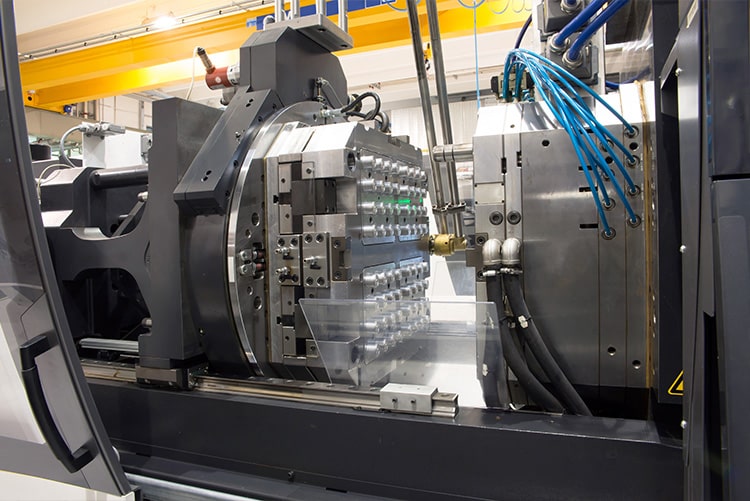
Injection molding is a highly efficient method for the seamless demolding of products. This preferential manufacturing process produces vast quantities of uniform components with exact precision. From aerospace and automotive to medical devices and electronics, there are few industries and applications injection molding doesn’t touch.
To create items such as plastic components, housings, toys, packaging, and more, companies prefer injection molding for its high production speed, low labor costs, minimal material waste, and the ability to create complex shapes and fine details.
For all of its advantages, the injection molding process also poses some challenges. Here, we’ll discuss these difficulties and how thin dense chrome coatings can act as a mold release agent to help maintain product quality and production efficiency.
Common Demolding Difficulties
Demolding refers to the process of removing a solidified part from a mold. In the context of injection molding, once the molten material is injected into the mold and has cooled and solidified, the mold is opened, and the part is ejected or removed.
Several issues can arise during the demolding process that may affect the quality of the final product, as well as the efficiency and cost-effectiveness of the production process.
One common challenge is that plastic or other materials can adhere to the mold surface, leading to incomplete or flawed final products. This can be caused by various factors, such as choosing materials that are more prone to sticking, inadequate draft angle, too high an injection pressure, or a too-short cooling time.
Furthermore, if the part doesn’t cool adequately before ejection or if the cooling is uneven, the part can warp. Also, materials shrink as they cool; this can sometimes lead to a fit that is too tight between the part and the mold, making demolding difficult.
Another issue involves maintenance — or lack thereof. For starters, various surface defects can be introduced during demolding, such as scratches, gouges, or blemishes, especially if the part is delicate or the mold is in poor condition. Improper ejection can cause damage to the mold, which can be expensive to repair and result in downtime for the production line.
Due to these demolding difficulties, poor product quality, increased material waste, and additional time to rectify defective parts can result. So, how can these issues be effectively addressed?
Mold Release Agent to the Rescue
A mold release agent is a substance or coating that, when applied to injection mold surfaces, ensures easy removal of the molded part. Mold release agents reduce friction and adhesion, protecting the part and the mold from damage.
Some of the other benefits of mold release agents include:
- Improved product quality: A mold release agent can prevent products from sticking to the mold’s surface, improving component quality and durability.
- Increased mold lifespan: Mold surfaces are easier to clean, thus reducing wear and tear.
- Increased productivity: This goes without saying; shorter cycle times are better for business.
- Cost savings: Considerable savings on maintenance and mold replacement costs should also be noted.
Chromium Coating as a Mold Release Agent
Now that we have covered the general characteristics of a mold release agent, it’s time to make the case for chromium coatings. These coatings, such as Armoloy® thin dense chrome, are also used as mold release agents due to their unique features.
Why should you opt for a chromium coating?
- Smooth surface: Chromium coatings, especially TDC, offer a super-smooth surface, reducing the points of contact where materials might adhere.
- Non-stick property: There is less adherence of injection materials to the mold, and therefore, easier component removal.
- Corrosion resistance: Chromium coatings also protect the molds from corrosive agents, increasing their lifespan.
Why Choose Armoloy®?
Through precise, engineered deposits, Armoloy TDC®, XADC®, and Nyflon 25® add incredible value to plastic injection molding applications, as well as those in the areas of extrusion and thermoforming. Some typical applications include core and cavity blocks, lifters, sleeves, ejector pins, bushings, rotating cores, and inserts.
Particularly in the case of glass-filled resins, Armoloy coatings improve cycle time and wear life by imparting a harder, more lubricious surface to molding components. Unlike many other surface treatments, Armoloy coatings can be removed and reapplied, as wear life and maintenance schedules dictate, with no damage incurred by the base metal. Distinctive advantages of Armoloy’s thin dense chrome:
- Precision: Armoloy TDC® is no ordinary chromium coating. Its thin, compact structure ensures that it doesn’t excessively increase the thickness of mold surfaces, preserving the original mold dimensions and tolerances.
- Uniformity: Armoloy’s skilled application of TDC guarantees consistent coverage, ensuring that every part of the mold enjoys its protective and release properties.
- Longevity: Armoloy TDC® has a proven track record of enduring numerous molding cycles, making it a long-term investment that pays off.
- Versatility: In addition to standard molding steels such as A-2, S-7, and H-13, Armoloy coatings can be applied to stainless steel, copper, beryllium, and bronze alloys such as Ampcoloy.
- Re-application: Armoloy TDC® can be re-applied many times, minimizing the cost of new molds.
Whether boosting manufacturing efficiency, ensuring superior product quality, or extending machinery lifespan, the argument for using Armoloy® thin dense chrome for injection molding is compelling.